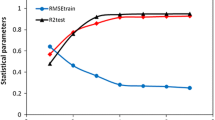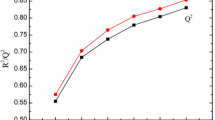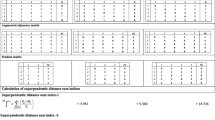Abstract
The kappa opioid receptor antagonists have been studied for their quantitative structure–activity relationships. A dataset containing 45 inhibitors of the human ether-a-go–go voltage-gated ion-channel with known inhibitory was used. The whole dataset was divided into a training set and a test set based on of K-means clustering technique. Multiple linear regressions were employed to model the relationships between molecular descriptors and biologic activity of molecules using stepwise and genetic algorithm methods as variable selection tools. A comparison between the attained results indicated the superiority of the genetic algorithm over the stepwise multiple regression method in the feature selection. Support vector machine was also employed to model the non-linear structure–activity relationships. The models were validated using leave-one-out cross-validation, Y-randomization test, and applicability domain. The results showed that the linear model does not perform as well as the non-linear model in terms of predictive ability. The results suggest that the shape, relative negative charge, atomic masses, atomic polarizability, and atomic electronegativity are the main independent factors contributing to the hard inhibitory of the studied compounds.





Similar content being viewed by others
References
Ackley MA, Hurley RW, Virnich DE, Hammond DL (2001) A cellular mechanism for the antinociceptive effect of a kappa opioid receptor agonist. Pain 91:377–388
Agrawal VK, Khadikar PV (2001) QSAR prediction of toxicity of nitrobenzenes. Bioorg Med Chem 9:3035–3040
Brugel TA, Smith RW, Balestra M, Becker C, Daniels T, Hoerter TN, Koether GM, Throner SR, Panko LM, Folmer JJ, Cacciola J, Hunter AM, Liu RF, Edwards PD, Brown DG, Gordon J, Ledonne NC, Pietras M, Schroeder P, Sygowski LA, Hirata LT, Zacco A, Peters MF (2010a) Discovery of 8-azabicyclo 3.2.1 octan-3-yloxy-benzamides as selective antagonists of the kappa opioid receptor. Part 1. Bioorg Med Chem Lett 20:5847–5852
Brugel TA, Smith RW, Balestra M, Becker C, Daniels T, Koether GM, Throner SR, Panko LM, Brown DG, Liu RF, Gordon J, Peters MF (2010b) SAR development of a series of 8-azabicyclo 3.2.1 octan-3-yloxy-benzamides as kappa opioid receptor antagonists. Part 2. Bioorg Med Chem Lett 20(18):5405–5410
Carlezon WA, Beguin C, DiNieri JA, Baumann MH, Richards MR, Todtenkopf MS, Rothman RB, Ma ZZ, Lee DYW, Cohen BM (2006) Depressive-like effects of the kappa-opioid receptor agonist salvinorin A on behavior and neurochemistry in rats. J Pharmacol Exp Ther 316:440–447
Cavalli A, Poluzzi E, De Ponti F, Recanatini M (2002) Toward a pharmacophore for drugs inducing the long QT syndrome: insights from a CoMFA study of HERG K+ channel blockers. J Med Chem 45:3844–3853
Ekins S, Crumb WJ, Sarazan RD, Wikel JH, Wrighton SA (2002) Three-dimensional quantitative structure-activity relationship for inhibition of human ether-a-go–go-related gene potassium channel. J Pharmacol Exp Ther 301:427–434
Eriksson L, Jaworska J, Worth AP, Cronin MTD, McDowell RM, Gramatica P (2003) Methods for reliability and uncertainty assessment and for applicability evaluations of classification- and regression-based QSARs. Environ Health Perspect 111:1361–1375
Everitt B (1993) Cluster analysis, 3rd edn. E. Arnold, London
Fields H (2004) State-dependent opioid control of pain. Nat Rev Neurosci 5:565–575
Gilbert PE, Martin WR (1976) The effects of morphine and nalorphine-like drugs in the nondependent, morphine-dependent and cyclazocine-dependent chronic spinal dog. J Pharmacol Exp Ther 198:66–82
Gramatica P (2007) Principles of QSAR models validation: internal and external. QSAR Comb Sci 26:694–701
Habibi-Yangjeh A, Pourbasheer E, Danandeh-Jenagharad M (2008a) Prediction of basicity constants of various pyridines in aqueous solution using a principal component-genetic algorithm-artificial neural network. Monatsh Chem 139:1423–1431
Habibi-Yangjeh A, Pourbasheer E, Danandeh-Jenagharad M (2008b) Prediction of melting point for drug-like compounds using principal component-genetic algorithm-artificial neural network. Bull Kor Chem Soc 29:833–841
Knoll AT, Meloni EG, Thomas JB, Carroll FI, Carlezon WA (2007) Anxiolytic-like effects of kappa-opioid receptor antagonists in models of unlearned and learned fear in rats. J Pharmacol Exp Ther 323:838–845. doi:10.1124/jpet.107.127415
Leonard JT, Roy K (2006) On selection of training and test sets for the development of predictive QSAR models. QSAR Comb Sci 25:235–251
Mague SD, Pliakas AM, Todtenkopf MS, Tomasiewicz HC, Zhang Y, Stevens WC, Jones RM, Portoghese PS, Carlezon WA (2003) Antidepressant-like effects of kappa-opioid receptor antagonists in the forced swim test in rats. J Pharmacol Exp Ther 305:323–330
Martin WR, Eades CG, Thompson JA, Huppler RE, Gilbert PE (1976) The effects of morphine- and nalorphine-like drugs in the nondependent and morphine-dependent chronic spinal dog. J Pharmacol Exp Ther 197:517–532
Massart DL, Vandeginste BG, Buydens LM, De Jong S, Lewi PJ, Smeyers-Verbeke J (1998) Handbook of chemometrics and qualimetrics data handling in science and technology, vol 20. Elsevier, Amsterdam
McLaughlin JP, Marton-Popovici M, Chavkin C (2003) kappa opioid receptor antagonism and prodynorphin gene disruption block stress-induced behavioral responses. J Neurosci 23:5674–5683
Netzeva TI, Worth AP, Aldenberg T, Benigni R, Cronin MTD, Gramatica P, Jaworska JS, Kahn S, Klopman G, Marchant CA, Myatt G, Nikolova-Jeliazkova N, Patlewicz GY, Perkins R, Roberts DW, Schultz TW, Stanton DT, van de Sandt JJM, Tong WD, Veith G, Yang CH (2005) Current status of methods for defining the applicability domain of (quantitative) structure-activity relationships—the report and recommendations of ECVAM Workshop 52. Atla-Altern Lab Anim 33:155–173
Portoghese PS, Nagase H, Lipkowski AW, Larson DL, Takemori AE (1988) Binaltorphimine-related bivalent ligands and their kappa opioid receptor antagonist selectivity. J Med Chem 31:836–841
Pourbasheer E, Riahi S, Ganjali MR, Norouzi P (2009) Application of genetic algorithm-support vector machine (GA-SVM) for prediction of BK-channels activity. Eur J Med Chem 44:5023–5028
Pourbasheer E, Riahi S, Ganjali MR, Norouzi P (2010a) QSAR study on melanocortin-4 receptors by support vector machine. Eur J Med Chem 45:1087–1093
Pourbasheer E, Riahi S, Ganjali MR, Norouzi P (2010b) Quantitative structure-activity relationship (QSAR) study of interleukin-1 receptor associated kinase 4 (IRAK-4) inhibitor activity by the genetic algorithm and multiple linear regression (GA-MLR) method. J Enzym Inhib Med Chem 25:844–853
Pourbasheer E, Riahi S, Ganjali MR, Norouzi P (2011) QSAR study of C allosteric binding site of HCV NS5B polymerase inhibitors by support vector machine. Mol Divers 15:645–653
Riahi S, Pourbasheer E, Dinarvand R, Ganjali MR, Norouzi P (2008) Exploring QSARs for antiviral activity of 4-alkylamino-6-(2-hydroxyethyl)-2-methylthiopyrimidines by support vector machine. Chem Biol Drug Des 72:205–216
Riahi S, Pourbasheer E, Ganjali MR, Norouzi P (2009) Investigation of different linear and nonlinear chemometric methods for modeling of retention index of essential oil components: concerns to support vector machine. J Hazard Mater 166:853–859
Roche O, Trube G, Zuegge J, Pflimlin P, Alanine A, Schneider G (2002) A virtual screening method for prediction of the hERG potassium channel liability of compound libraries. ChemBioChem 3:455–459
Roy K, Mandal AS (2008) Development of linear and nonlinear predictive QSAR models and their external validation using molecular similarity principle for anti-HIV indolyl aryl sulfones. J Enzym Inhib Med Chem 23:980–995
Shapiro S, Guggenheim B (1998) Inhibition of oral bacteria by phenolic compounds—Part 1. QSAR analysis using molecular connectivity. Quant Struct-Act Relat 17:327–337
Thomas JB, Atkinson RN, Rothman RB, Fix SE, Mascarella SW, Vinson NA, Xu H, Dersch CM, Lu YF, Cantrell BE, Zimmerman DM, Carroll FI (2001) Identification of the first trans-(3R,4R)-dimethyl-4-(3-hydroxyphenyl)piperidine derivative to possess highly potent and selective opioid kappa receptor antagonist activity. J Med Chem 44:2687–2690
Todeschini R (2007) Milano Chemometrics and QSPR Group, http://www.disat.unimib.it/chm
Todeschini R, Consonni V (2000) Handbook of molecular descriptors. Methods and principles in medicinal chemistry, vol 11. Wiley-VCH, Weinheim
Vapnik VN (2000) The nature of statistical learning theory. Statistics for engineering and information science, 2nd edn. Springer, New York
Vink R, Portoghese PS, Faden AI (1991) Kappa-opioid antagonist improves cellular bioenergetics and recovery after traumatic brain injury. Am J Physiol 261:R1527–R1532
Wang WJ, Xu ZB, Lu WZ, Zhang XY (2003) Determination of the spread parameter in the Gaussian kernel for classification and regression. Neurocomputing 55:643–663
Yap YG, Camm AJ (1999) Arrhythmogenic mechanisms of non-sedating antihistamines. Clin Exp Allergy 29:174–181
Author information
Authors and Affiliations
Corresponding author
Rights and permissions
About this article
Cite this article
Pourbasheer, E., Beheshti, A., Khajehsharifi, H. et al. QSAR study on hERG inhibitory effect of kappa opioid receptor antagonists by linear and non-linear methods. Med Chem Res 22, 4047–4058 (2013). https://doi.org/10.1007/s00044-012-0412-4
Received:
Accepted:
Published:
Issue Date:
DOI: https://doi.org/10.1007/s00044-012-0412-4




